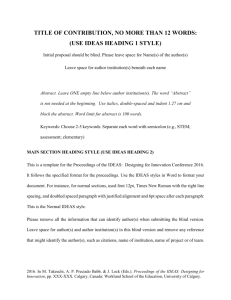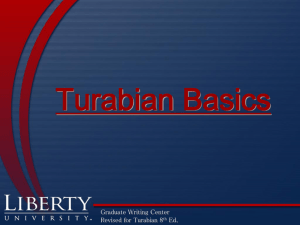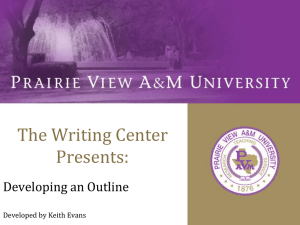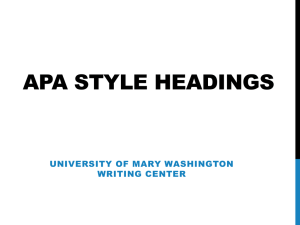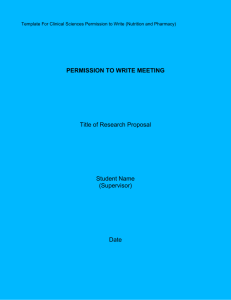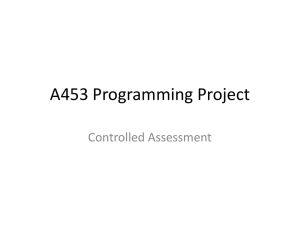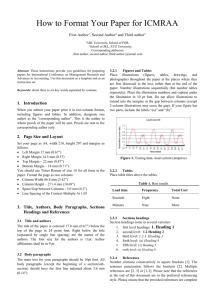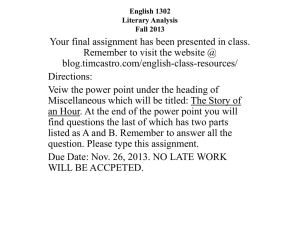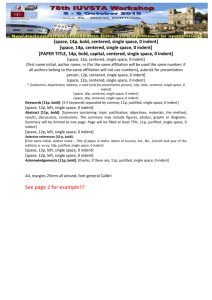Formatting Guidelines - PME
advertisement
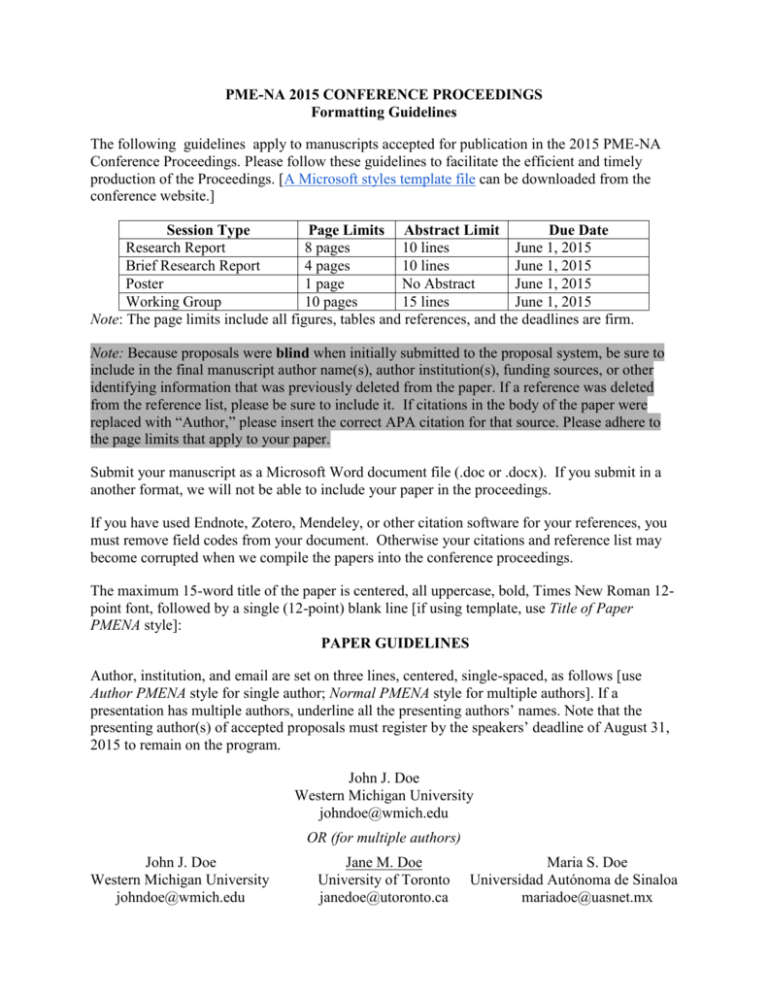
PME-NA 2015 CONFERENCE PROCEEDINGS Formatting Guidelines The following guidelines apply to manuscripts accepted for publication in the 2015 PME-NA Conference Proceedings. Please follow these guidelines to facilitate the efficient and timely production of the Proceedings. [A Microsoft styles template file can be downloaded from the conference website.] Session Type Page Limits Abstract Limit Due Date Research Report 8 pages 10 lines June 1, 2015 Brief Research Report 4 pages 10 lines June 1, 2015 Poster 1 page No Abstract June 1, 2015 Working Group 10 pages 15 lines June 1, 2015 Note: The page limits include all figures, tables and references, and the deadlines are firm. Note: Because proposals were blind when initially submitted to the proposal system, be sure to include in the final manuscript author name(s), author institution(s), funding sources, or other identifying information that was previously deleted from the paper. If a reference was deleted from the reference list, please be sure to include it. If citations in the body of the paper were replaced with “Author,” please insert the correct APA citation for that source. Please adhere to the page limits that apply to your paper. Submit your manuscript as a Microsoft Word document file (.doc or .docx). If you submit in a another format, we will not be able to include your paper in the proceedings. If you have used Endnote, Zotero, Mendeley, or other citation software for your references, you must remove field codes from your document. Otherwise your citations and reference list may become corrupted when we compile the papers into the conference proceedings. The maximum 15-word title of the paper is centered, all uppercase, bold, Times New Roman 12point font, followed by a single (12-point) blank line [if using template, use Title of Paper PMENA style]: PAPER GUIDELINES Author, institution, and email are set on three lines, centered, single-spaced, as follows [use Author PMENA style for single author; Normal PMENA style for multiple authors]. If a presentation has multiple authors, underline all the presenting authors’ names. Note that the presenting author(s) of accepted proposals must register by the speakers’ deadline of August 31, 2015 to remain on the program. John J. Doe Western Michigan University johndoe@wmich.edu OR (for multiple authors) John J. Doe Western Michigan University johndoe@wmich.edu Jane M. Doe University of Toronto janedoe@utoronto.ca Maria S. Doe Universidad Autónoma de Sinaloa mariadoe@uasnet.mx The abstract follows the author information and should not exceed 10 lines (15 lines for Working Groups). It is preceded and followed by a single (12-point) blank line, but it is not indented. The abstract should be in italics [use Abstract PMENA style]. The abstract should be followed by at least one and at most four key words from the keyword list appended to this document, formatted as follows: Keywords: Curriculum, Secondary Mathematics, Teacher Knowledge [use Normal PMENA style] All text in the body of the paper should be Times New Roman, 12-point font, 1-inch margins, and single-spaced [use Normal PMENA style]. You should use the ruler tool to indent the first line of each paragraph ¼ inch. Do not use the space bar or tab key to indent. To use the ruler bar, grab the top triangle at the left edge of the ruler and drag it to the ¼ inch mark. There should be no blank lines between paragraphs. Do not use headers, footers, or page numbers. Headings All headings in the paper should be bold, Times New Roman 12-point font. Please limit your headings to the following three levels: First Level Heading Text begins here. Second Level Heading Text begins here. Third level heading. Text begins here. First Level Headings [use First Level Heading PMENA style] should be centered, bold font, with only the first letter of each word capitalized. Each First Level Heading should be preceded by a single (12-point) blank line, but should not be followed by a blank line. Indent the first line of text ¼ inch after a First Level Heading. Second Level Headings [use Second Level Heading PMENA] should be left justified, bold, with only the first letter of each word capitalized. Second Level Headings are neither preceded nor followed by a blank line. Indent the first line of text ¼ inch after a Second Level Heading. Third Level Headings [use Normal PMENA style and bold the heading and period] should be indented ¼ inch, bold, and followed by a period. Only the first letter of the first word of the heading title should be capitalized. Begin typing the text after the period at the end of the heading. Quotations A quotation longer than 40 words should be formatted as a “block quote”—as this paragraph is formatted [use Block Quote PMENA style]. Begin the quote on a new line and indent the entire quote ¼ inch on the left. To do so on the ruler bar, grab both the top and bottom triangles on the ruler bar and drag them to the ¼ inch mark. No quotation marks are used; a period should appear at the end of the quote; and the reference (author, year, page number) should appear at the end of the quote with no period after it. Insert a blank line before and/or after the block quote if needed to distinguish it from other text (as in this example). Indent the sentence following the block quote only if it begins a new paragraph. Transcripts Transcripts should begin on a new line, with the first line indented ¼ inch (drag the upper triangle to the ¼-inch mark) [use Transcript PMENA style]. Indent subsequent lines using a hanging indent set at ½ inch (drag the lower triangle to the ½-inch mark). Italicize the speaker’s name on the first line, followed by a colon, as shown below. Teacher: So what’s the fraction name for that? What do we call this in fraction words? Student: One-fourth. Teacher: Yes, one-fourth. Okay. The bottom number tells how many pieces in the whole, right? How many pieces in this whole? Lists In a paragraph or sentence, identify elements in a series by lowercase letters in parentheses: (a) the first item in the series, (b) the second item, and (c) the third item. Use semicolons instead of commas if the series elements contain commas. If the listed items are separate paragraphs, use Arabic numerals followed by a period or bullets. Use the automated numbering or bullets in Microsoft Word, which will provide the appropriate indentation of each line [use Normal PMENA style]. 1. The first enumerated paragraph should be presented in this manner. 2. The second paragraph … 3. The third paragraph … Tables and Figures All tables and figures should be placed in the document as appropriate, with a blank line both preceding and following the table or figure. If necessary, re-size large tables or graphics to fit within the 1-inch margins and to keep your document within the number of pages allowed. Create tables using the Table feature of Microsoft Word (Tables are those graphics consisting of rows and columns; all other graphics should be designated as Figures). Use the First Level Heading PMENA for both table and figure titles, centering the table title above the table, and centering the figure title below the figure or graphic. Examples follow. Table 1: Conference Deadlines Research & Brief Research Reports Posters & Working Groups Proposals Due xxxx xxxx Figure 1: PME-NA 2015 Banner Final Papers Due xxxx xxxx Endnotes In general, avoid endnotes. If you must indicate an endnote, use the endnote function of Microsoft Word; do not use the footnote function. The heading for endnotes should be treated as a First Level Heading. Indent the first line of each endnote ¼ inch; use Times New Roman, 12point font, single-spaced. Do not put a blank line between endnotes. Acknowledgments Any necessary acknowledgments should immediately precede the References and should be formatted as a First Level Heading. Do not put blank lines between multiple acknowledgments. References References should be Times New Roman, 10-point font, single-spaced, with ¼-inch hanging indent—as this paragraph is formatted [use Reference PMENA style]. To set up a hanging indent using the ruler bar, grab the bottom triangle at the left edge of the ruler and drag it to the ¼ inch mark. Do not use the return key, space bar, or tab key to create a hanging indent. There should be no blank lines between references. All references should follow APA format; a variety of sample references are provided below. Note that titles of books and journals should be italicized, not underlined. There should be no underlined text in the manuscript. Borko, H., & Putnam, R. T. (1996). Learning to teach. In D. C. Berliner & R. C. Calfee (Eds.), Handbook of educational psychology (pp. 673-708). New York, NY: Simon and Schuster Macmillan. Bos, B. (2011). Professional development for elementary teachers using TPACK. Contemporary Issues in Technology and Teacher Education, 11(2). Retrieved from http://www.citejournal.org/vol11/iss2/mathematics/article1.cfm Common Core State Standards Initiative (CCSSI). (2010). Common core state standards for mathematics. Retrieved from http://www.corestandards.org/the-standards/mathematics Herbst, P., & Chazan, D. (2006). Producing a viable story of geometry instruction: What kind of representation calls forth teachers’ practical rationality? In S. Alatorre, J. L. Cortina, M. Sáiz, & A. Méndez. (Eds.), Proceedings of the 28th North American Group for the Psychology of Mathematics Education Conference (Vol. 2, pp. 213220). Mérida, México: UPN. National Council of Teachers of Mathematics. (2000). Principles and standards for school mathematics. Reston, VA: Author. Stanic, G. M. A., & Kilpatrick, J. (Eds.). (2003). A history of school mathematics (Vol. 1). Reston, VA: National Council of Teachers of Mathematics. Yackel, E., & Cobb, P. (1996). Sociomathematical norms, argumentation, and autonomy in mathematics. Journal for Research in Mathematics Education, 27, 458-477.
